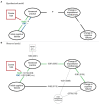Individual Differences in Cognitive Functioning Predict Compliance With Restoration Skills Training but Not With a Brief Conventional Mindfulness Course
- PMID: 35310259
- PMCID: PMC8926983
- DOI: 10.3389/fpsyg.2022.715411
Individual Differences in Cognitive Functioning Predict Compliance With Restoration Skills Training but Not With a Brief Conventional Mindfulness Course
Abstract
Mindfulness training is often promoted as a method to train cognitive functions and has shown such effects in previous studies. However, many conventional mindfulness exercises for beginners require cognitive effort, which may be prohibitive for some, particularly for people who have more pronounced cognitive problems to begin with. An alternative mindfulness-based approach, called restoration skills training (ReST), draws on a restorative natural practice setting to help regulate attention effortlessly and promote meditative states during exercises. Previous research has shown that a 5-week ReST course requires less effort and is attended by higher compliance with practice recommendations than a conventional mindfulness course, without compromising long-term outcomes. Here, we compare ReST and a formally matched conventional mindfulness course regarding the role that initial individual differences in cognitive functioning play in determining practice compliance and long-term improvements in dispositional mindfulness and cognitive functioning. In line with expectations, ReST participants who had more pronounced cognitive problems to begin with practiced more during the course, which in turn explained much of their improvement in dispositional mindfulness and cognitive functioning. In contrast, initial cognitive functioning did not explain practice and improvement in the conventional mindfulness course. The results provide further support for the potential utility of ReST as a low-effort method for enhancing cognitive functioning among people who would struggle with the demands of conventional mindfulness training. With careful integration of mindfulness practices with a restorative natural setting, these people can develop mindfulness and self-regulation capabilities without relying on effortful training.
Keywords: cognitive functioning; compliance; effortless attention; mediation; mindfulness; moderation; nature; restorative environments.
Copyright © 2022 Lymeus.
Conflict of interest statement
The author declares that the research was conducted in the absence of any commercial or financial relationships that could be construed as a potential conflict of interest.
Figures


Similar articles
-
Mindfulness-Based Restoration Skills Training (ReST) in a Natural Setting Compared to Conventional Mindfulness Training: Psychological Functioning After a Five-Week Course.Front Psychol. 2020 Aug 12;11:1560. doi: 10.3389/fpsyg.2020.01560. eCollection 2020. Front Psychol. 2020. PMID: 32903687 Free PMC article.
-
Restoration Skills Training in a Natural Setting Compared to Conventional Mindfulness Training: Sustained Advantages at a 6-Month Follow-Up.Front Psychol. 2022 Aug 1;13:763650. doi: 10.3389/fpsyg.2022.763650. eCollection 2022. Front Psychol. 2022. PMID: 35978765 Free PMC article.
-
Building mindfulness bottom-up: Meditation in natural settings supports open monitoring and attention restoration.Conscious Cogn. 2018 Mar;59:40-56. doi: 10.1016/j.concog.2018.01.008. Epub 2018 Feb 10. Conscious Cogn. 2018. PMID: 29438869
-
Mindfulness Training: Can It Create Superheroes?Front Psychol. 2019 Mar 26;10:613. doi: 10.3389/fpsyg.2019.00613. eCollection 2019. Front Psychol. 2019. PMID: 30971978 Free PMC article. Review.
-
Mindfulness and bodily distress.Dan Med J. 2012 Nov;59(11):B4547. Dan Med J. 2012. PMID: 23171754 Review.
References
-
- Banerjee M., Cavanagh K., Strauss C. (2018). Barriers to mindfulness: A path analytic model exploring the role of rumination and worry in predicting psychological and physical engagement in an online mindfulness-based intervention. Mindfulness 9, 980–992. doi: 10.1007/s12671-017-0837-4, PMID: - DOI - PMC - PubMed
Publication types
LinkOut - more resources
Full Text Sources

